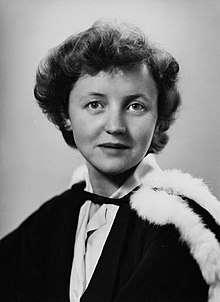Brenda Swinbank
Brenda Swinbank (married name Heywood) (born 2 February 1929) is an English archaeologist, one of the first women in Britain to become a professional archaeologist.[1][2] She specialised in studying Hadrian's Wall, and was instrumental in bringing to publication excavations under York Minster.[2][1]
Brenda Swinbank | |
|---|---|
 Brenda Swinbank, archaeologist | |
| Born | 2 February 1929 |
| Occupation | Archaeologist |
| Known for | One of the first women in Britain to become a professional archaeologist |
Education and career
Swinbank studied history at Durham University where she was inspired by Eric Birley, who later described her as a "really competent excavator and field archaeologist."[1] She supervised excavations at Birdoswald with J P Gillam in 1950, before completing her thesis The Vallum Reconsidered, for which she received a doctorate from Durham University in 1954.[3][4] This made her the third British woman to be awarded a PhD for a thesis on the archaeology of Britain.[1] During her studies at Durham she was a member of St Aidan's Society.[5]
In 1958, she featured alongside Eric Birley, John Gillam and Kate Hodgson in a BBC Home Service broadcast marking 1,800 years' study of Hadrian's Wall.[6] However, despite her achievements she was not granted a permanent university position, and in the autumn of that year took up an appointment as Assistant History Mistress at Ackworth School,[1] one of a few Quaker educational establishments in England.
It was not until the late 1960s that Swinbank was able to again involve herself more fully in archaeology. She connected with Peter Wenham, an archaeologist and contact of Eric Birley, whom she began to assist with lectures and excavations, including preparing the final report of the excavations of the vicus at Malton in 1971.[7][8] In 1974, she joined in the post-excavation processing of the great mass of archaeological materials unearthed during the stabilization of York Minster. In the words of her biographer, these consisted of "rooms full of documents, soil samples, pieces of pottery and bone, 3,000 photographs, chunks of carved stonework and even one large block of dirt weighing several tonnes."[1] She brought these to publication as the first volume of the York Minster materials and also, in 1992, became a director of The Yorkshire Architectural & York Archaeological Society.[1][9][10] After this Swinbank returned to her former interests on the vallum of Hadrian's Wall, which, with the assistance of David Breeze, she published in the late 2000s.[1]
Personal life
Brenda Swinbank was born on 2 February 1929, in Ackworth, England.[9] She married Peter Heywood, a teacher and colleague at the Friends’ School in Ackworth, with whom she had two sons and a daughter who died.[1] One son, Jeremy Heywood, went on to become a Cabinet Secretary and Head of the Home Civil Service;[11] he died on 4 November 2018, aged 56.
References
- "Book Review – Recollections of a Female Archaeologist: A Life of Brenda Swinbank". HARN Weblog. 2018-06-29. Retrieved 2018-07-27.
- Recollections of a Female Archaeologist.
- Wilmott, Tony (2013-04-15). Hadrian's Wall: Archaeological research by English Heritage 1976-2000. English Heritage. pp. 61–62. ISBN 9781848021587.
- "Items where Author is "Swinbank, Brenda" - Durham e-Theses". etheses.dur.ac.uk. Retrieved 2018-07-27.
- "Higher Degrees". Durham University Gazette. 1 (New Series): 2. 16 August 1954. Retrieved 10 December 2019.
- "The Archaeologist - BBC Home Service Basic - 12 December 1958 - BBC Genome". The Radio Times (1830): 40. 1958-12-05. Retrieved 2018-07-27.
- Frere, S.S.; Hassall, M.W.C.; Tomlin, R.S.O. (1988). "Roman Britain in 1987". Britannia. 19: 504 n.95. doi:10.2307/526214. JSTOR 526214.
- Wilson, D. R.; Wright, R.P.; Hassall, M.W.C. (1971). "Roman Britain in 1970". Britannia. 2: 252–253. doi:10.2307/525817. JSTOR 525817.
- "DueDil". www.duedil.com. Retrieved 2018-07-27.
- "yayas". yayas. Retrieved 2018-07-27.
- "Sir Jeremy Heywood - GOV.UK". www.gov.uk. Retrieved 2018-07-27.